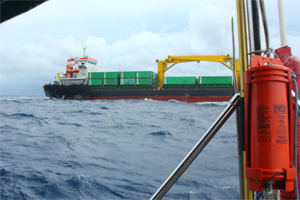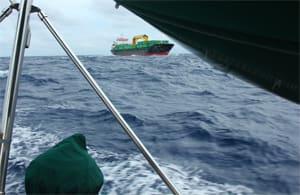To the editor: Hollywood would like to make you believe that steel containers, fallen from ships, bob around the world’s oceans ready to sink the dreams of unsuspecting world cruisers. However, it is not semi-submerged containers an ocean-crossing cruiser needs to be overly concerned about; the cargo ships from which they fall are the far greater menace.
Anyone who has sailed across oceans for a while certainly has dodged a large ship. On the bridge of most ships, the officer on watch (OOW) and the crew are vigilant and do what they can to avoid a closing situation with a relatively tiny plastic sailboat. But there are a percentage of ships’ crews not doing the job of keeping a proper watch.
There have been numerous incidents where neither the offending ship nor the sailing yacht yielded, resulting in serious damage to the sailboat. In fact, these collisions can happen without the OOW on the ship even realizing a sinking had occurred.
When the weather is clear, it is especially annoying and dangerous for large steel freighters to fail to follow the International Regulations for Preventing Collisions at Sea (COLREGS), which are internationally agreed-upon navigational rules as published by the International Maritime Organization (IMO). But the failure is frequent. So when I saw the cargo ship Pulau Layang, registered in Jakarta, thundering across the ocean toward our 40-foot sailboat from our port quarter in a converging (rather than an overtaking) situation in the late afternoon with good visibility, I wanted irrefutable proof of what was happening.
Pulau Layang is required to display a Class A AIS signal. On our Class B AIS transceiver, the only signal showing was from a tugboat far to our south. We were in offshore waters in Indonesia, traveling southwest from the city of Tual to Dili, Timor-Leste — a passage of 500 miles. As the big freighter closed rapidly, I had time to make only one call on Channel 16: “To the ship heading southwest, this is Brick House, the sailboat dead ahead of you!” After no response, I grabbed my camera. As the autopilot steered, I worked fast to take evidential pictures of the approaching ship in the background and what parts of our cockpit would fit in the foreground. This would be one time I would try to turn the tables on a dangerous freighter violating several international regulations. I wanted the close proximity pictures to prove the closing situation, the clear visibility conditions and the wave height. Eventually, with Pulau Layang’s hull becoming frighteningly close to my port side, I turned hard to starboard and gybed to complete a 360-degree turn. I snapped a few more pictures with the ship now passing my stern. I didn’t rouse my wife, Rebecca, from the aft cabin until the ship had passed, the tense situation was over and Brick House was back on course.
As Pulau Layang steamed away, stacked high with green containers, I could see no one on deck or in the windows of the bridge or the bridge wing. The ship’s continued silence on the VHF stoked my irritation, bringing forth some salty language directed at the crew. It’s possible the crew understood little English, but my tone conveyed my displeasure. It is an IMO requirement that any person standing watch on a ship must have a solid grasp of English and be able to speak it clearly. They must also answer a call if they are called by ship name. From Pulau Layang, there was no response for the full hour I continued calling. But some of those early emotionally charged calls would later worry me.
Pulau Layang receded over the horizon as Rebecca and I tracked the ship on radar. From the cockpit I could clearly see the ship’s superstructure at what the radar showed to be six nautical miles. This was just part of the evidence that had to immediately be recorded. The actual latitude and longitude of the incident was noted. There was a tugboat named Drako Best showing on the AIS and all the particulars for that boat were noted. This would prove our AIS was functioning properly. The true direction of travel of Pulau Layang was noted as well as the direction of travel of Brick House and its speed over ground. Wind direction, wind speed, cloud cover, time of day in local time — anything that might be useful in an investigation of the incident and to support my contentions was recorded. When the final report was written, it would include all documentation particulars of our own boat. Most damning however, were the pictures.
But now the problem was who to report this situation to. Who would care? IMO does not have an enforcement arm so the responsibility rests with the flag state, the country in which the offending vessel is registered. The flag state is the only one that can discipline the crew and affect their licenses. Since Pulau Layang had a home port of Jakarta, then Indonesia is where I would have to hunt down the proper enforcement entity.
After logging in to the IMO’s Global Integrated Shipping Information System website as a public user and clicking on the icon for “Ship Particulars,” I could find the ship’s flag state, the registered owner and IMO number. Clicking on the icon for “Contact Points” then the radio button for “Flag State contact points for PSC (Port State Control) matters” and then where it says “Please Select,” I could scroll down to the flag state of the ship of interest where the name of the person in charge of enforcement and their contact information is given for filing a report about the ship.
 |
|
Pulau Layang nearing Brick House. |
|
Patrick Childress |
It might be a requirement to have ships’ watchkeepers be fluent in speaking English, but what about the people working in the foreign government? It would seem reasonable to send a report in their own language along with my English version and copies of the photographs.
After we docked in the city of Dili, at the first upscale waterfront hotel I walked into the two front desk workers were very conversant in English. They were more than happy to put my English report into their electronic translator and spit out a version in Indonesian. I checked the printout for obvious errors like where the electronic translator changed the name “Drako Best” to “Drako terbaik.” My new friends changed other electronic irregularities into what I hoped was a good mirror of the original report. But not only is it desirable to communicate in the language of the flag country, but also to make sure all measurements are stated in metric. Feet, inches and statute miles are not understood by most of the world.
My report, in Indonesian and English, was emailed to the two most promising titled offices on the IMO Indonesian contact site. Further Internet research revealed the address of the shipowner and operator. Printed out copies were mailed to the shipowner and ship operator, as certainly they would want to know how their ships are operated.
If the Pulau Layang incident happened in territorial waters of some westernized countries like Australia, New Zealand, Great Britain or the U.S., the nearest coast guard station would also receive my report and pass it up the chain of command. If there is an actual collision, you can be sure their interest level would be very high. These entities could impose enforcement actions including civil and administrative penalties. Depending on the outcome of an incident, the coast guard can also refer a case criminally. Generally, such an investigative effort done by the coast guard would be forwarded to the flag state.
However, most coast guards do not get involved with civil disputes. So if there is a collision, the owner of the damaged boat must quickly call an experienced maritime lawyer.
Whether it is the flag state or a foreign coast guard, investigators will take statements from the relevant crewmembers, review various ship’s documents and, in some situations, the information from the ship’s voyage data recorder (VDR). The VDR is a brightly colored box that can withstand high temperatures, explosions and sinking. The VDA records GPS position and heading, speed, radar, depth and other operational data. There are four microphones installed on the ceiling of the bridge and one on each wing deck to capture conversations and ship sounds. Those microphones, along with the recording of VHF transmissions, would have certainly captured my repetitious calls and that irritated call made at the ship. Like mom says, “Always speak politely as you never know who is listening.” VDR information is ultimately stored on a backup drive for at least 30 days before being overwritten. The VDR is required equipment on internationally operated ships. Pulau Layang, being a domestic carrier, might not have had a VDR.
I never heard back from the authorities in Jakarta whose business it is to investigate such incident reports. According to the IMO, this is not unusual as some flag states put enforcement low on their list of priorities. But I did hear from the general manager of the company that owns and operates Pulau Layang. The GM was appreciative to receive the report. He would investigate the matter to determine further training or discipline of the crew.
As more ocean-crossing yachts report the errant behavior of commercial ships, this may motivate the ships’ crews to give greater consideration to sailboats. For those little boats, there are avenues for payback.
—Patrick Childress is a professional captain with a Master’s 500-ton license. He and his wife Rebecca are in the eighth year of a circumnavigation on board their Valiant 40 Brick House.

